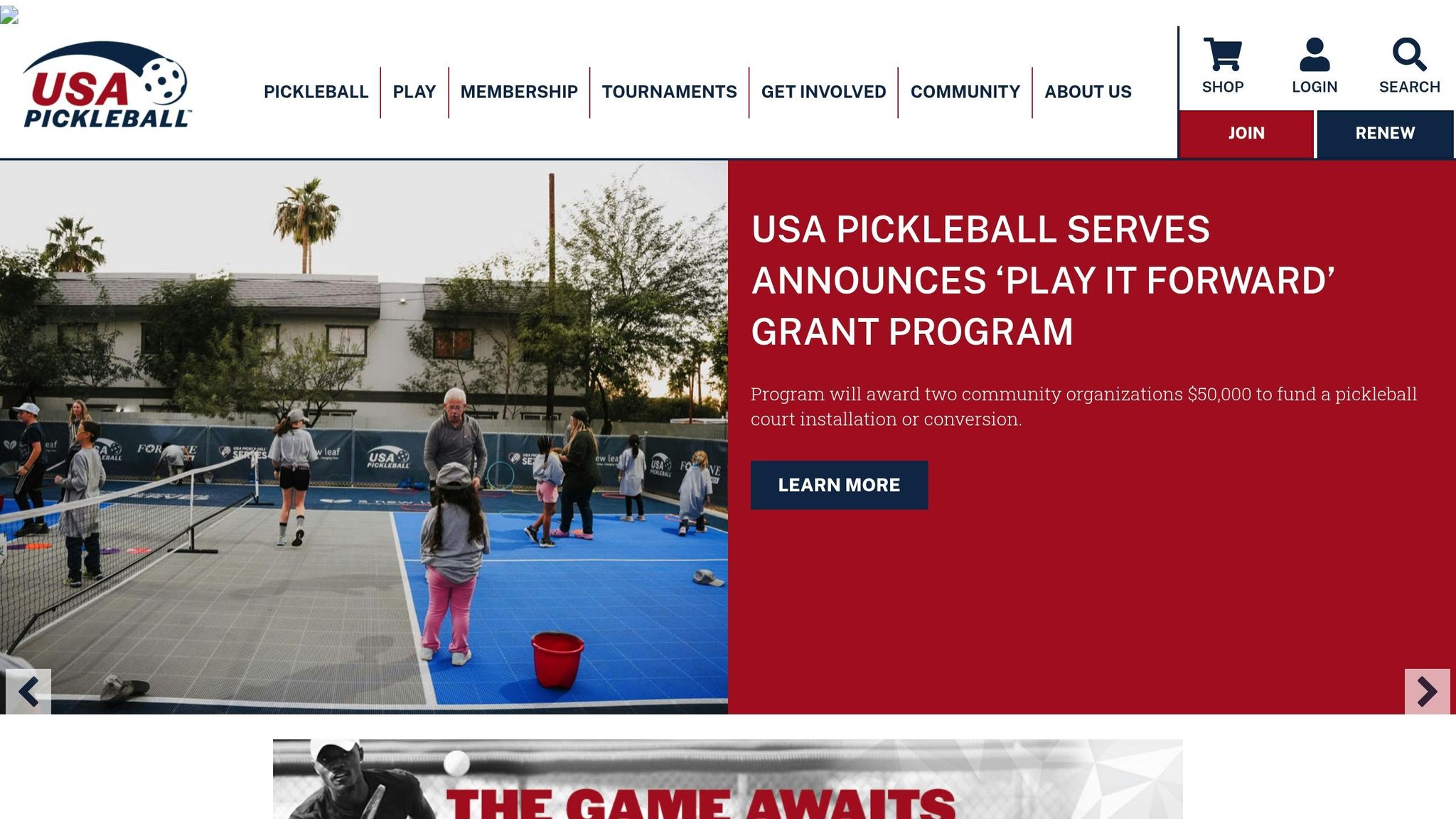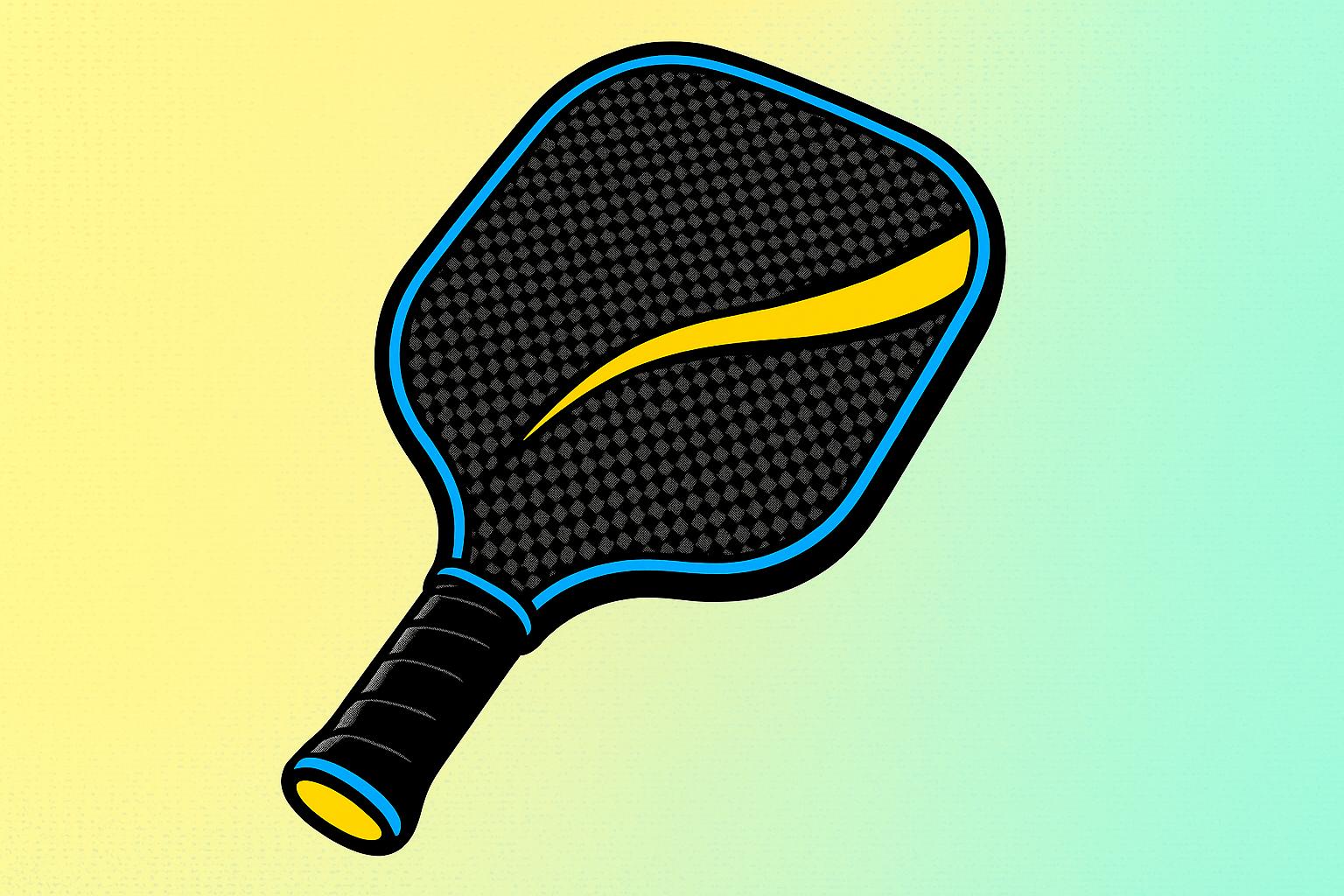Carbon fiber has changed the way pickleball paddles are made, offering a lightweight yet strong option for players. By weaving carbon strands into resin, manufacturers create paddles that are easy to handle, durable, and reduce vibrations during play. These paddles improve shot accuracy, reduce fatigue, and provide better control compared to other materials like fiberglass or wood.
Key Takeaways:
- Lightweight Advantage: Carbon fiber paddles weigh between 6–7.3 ounces, making them easier to maneuver during fast-paced games.
- Durability: The material lasts longer, resisting wear and maintaining performance over time.
- Improved Comfort: Carbon fiber absorbs vibrations, reducing strain on the wrist, elbow, and shoulder.
- Better Performance: Players gain more control, precision, and spin potential thanks to the material's stiffness and textured surface.
- Stylish Options: Brands like PLAY HENRY combine carbon fiber performance with sleek designs and custom color options.
Carbon fiber’s strength-to-weight ratio makes it a top choice for players seeking paddles that are light, durable, and effective on the court.
What's the best pickleball paddle material? | Is it worth it to upgrade to carbon fiber?
How Carbon Fiber Creates Lightweight Construction
Carbon fiber stands out for its ability to combine reduced weight with impressive durability, making it a top choice for pickleball paddles.
Carbon Fiber Manufacturing Process
The creation of carbon fiber paddles is a detailed process that transforms raw carbon into a strong yet lightweight paddle surface. It starts with producing carbon and spinning it into incredibly thin fibers - just 5–10 micrometers in diameter, much thinner than a strand of human hair. These fibers are then oxidized to enhance their strength before being woven into a fabric-like material.
Once the fibers are woven, they undergo thermoforming, where heat and pressure mold them into the paddle's shape. This step ensures the paddle's structural stability, reinforces its design, and optimizes the sweet spot for precise, controlled shots. Companies like PLAY HENRY rely on this precise process to create paddles that combine visual appeal with exceptional performance.
This careful production method is what gives carbon fiber paddles their standout strength-to-weight ratio.
Strength-to-Weight Ratio Explained
The manufacturing process results in a material with an extraordinary strength-to-weight ratio. This advantage comes from carbon fiber's atomic structure, where carbon atoms are bonded in microscopic crystals aligned in parallel. This alignment forms graphitic planes with optimized spacing, creating a structure that is both lightweight and incredibly strong.
With a density of just 1.6 g/cm³ compared to steel's 7.85 g/cm³, carbon fiber is about five times stronger than steel. In practical terms, this means carbon fiber can handle much heavier loads than metals like steel or aluminum while remaining significantly lighter. For pickleball players, this translates to paddles that deliver power and precision without the arm fatigue caused by heavier materials.
To achieve this performance, carbon fiber must contain at least 92% carbon by weight. This high carbon content, paired with its crystalline structure, gives the material superior mechanical strength, elasticity, heat resistance, and chemical resistance compared to organic fibers.
"Carbon fiber, celebrated for its strength-to-weight ratio, has become a staple in high-performance pickleball paddles." - LUXE Pickleball
Even though the difference between the lightest and heaviest paddles is only about 2 ounces (28.35 grams), every gram makes a difference. Carbon fiber's ability to maximize strength while minimizing weight is why it’s the go-to material for players seeking lightweight paddles that don’t compromise on performance.
Performance Benefits of Carbon Fiber Pickleball Paddles
Lightweight carbon fiber paddles are designed to enhance speed, control, and endurance, taking your game to the next level.
Improved Maneuverability and Reduced Fatigue
Most carbon fiber paddles weigh between 6 and 7.3 ounces, making them significantly lighter than many alternatives. This reduction in weight offers immediate advantages for both your gameplay and overall comfort.
The lighter design allows for quicker wrist movements, which is especially helpful during fast-paced net play. At the kitchen line, where reaction time is critical, a lightweight paddle can make all the difference. Additionally, carbon fiber helps dampen vibrations, which minimizes arm fatigue. Paired with the lighter weight, this means you can sustain your energy and performance even during extended matches.
For players managing joint pain or injuries in areas like the wrist, elbow, or shoulder, these paddles can provide much-needed relief. The agility and comfort they offer naturally translate into better shot control and overall gameplay.
Enhanced Control and Shot Precision
Carbon fiber strikes a balance between softness and stiffness, giving players excellent control over their shots. This balance is key for executing delicate, precise plays without compromising on power.
The rigidity of carbon fiber improves control by absorbing more energy upon impact compared to softer materials like fiberglass. This energy absorption lets you direct the ball with greater accuracy and confidence.
Additionally, textured surfaces on carbon fiber paddles increase spin potential and expand the sweet spot, reducing mishits and improving shot accuracy.
Longevity and Consistent Performance
Carbon fiber paddles are not just about performance - they are built to last. They outshine wood, composite, fiberglass, and even graphite paddles in durability, often holding up through 6 months to 3 years of frequent play.
Their thermoformed construction fuses layers into a seamless, sturdy design. Premium paddles made with T700 raw carbon fiber offer exceptional strength, standing up to wear and tear far longer than standard materials. Unlike other paddles, carbon fiber models resist developing soft spots or uneven wear, ensuring consistent performance even after countless games.
A great example of this durability comes from PLAY HENRY’s carbon fiber paddles. They not only deliver the performance benefits of carbon fiber but also feature sleek monochrome designs in colors like pastel pink, sky blue, and espresso brown. With these paddles, you’ll enjoy top-tier functionality while making a stylish statement on the court.
sbb-itb-c5e004d
Style and Customization: The PLAY HENRY Edge

PLAY HENRY paddles don’t just deliver on performance - they also turn heads with their design and personalization options. By combining cutting-edge carbon fiber technology with sleek, minimalist aesthetics, PLAY HENRY sets itself apart from competitors who often prioritize function over form. With these paddles, you don’t have to choose between performance and style - you get both.
Monochrome Design Options
PLAY HENRY offers seven monochrome colorways - espresso, tomato, butter, sky, bubblegum, eclipse, and matcha - that bring a polished, modern look to the court. These paddles aren’t just about appearances; they’re built with a carbon fiber surface that enhances durability and spin, paired with a Reactive Polymer Core for consistent ball response and reduced vibration. Unlike paddles cluttered with loud graphics or oversized logos, PLAY HENRY’s monochrome designs deliver a clean, timeless aesthetic that pairs effortlessly with any court outfit.
Custom Paddle Designs
For players who want something truly their own, PLAY HENRY goes a step further by offering custom paddle designs. This service allows you to create a paddle that reflects your personal style while maintaining the same high-performance features - like the carbon fiber surface and Reactive Polymer Core - found in every paddle. Whether you’re looking for a unique design or a specific color combination, your custom paddle will still deliver the lightweight feel, spin potential, and durability you expect. It’s personalization without compromise.
USAPA-Approved Performance Standards

Every PLAY HENRY paddle meets the rigorous standards set by the USA Pickleball Association (USAPA), meaning they’re approved for tournament play. These standards ensure paddles are made from rigid, non-compressible materials, adhere to size regulations (a maximum combined length and width of 24 inches, with a maximum length of 17 inches), and meet surface roughness and friction requirements. PLAY HENRY’s inclusion on the official equipment list - alongside over 2,500 paddles - is a testament to its commitment to quality and performance.
As USA Pickleball explains:
"The compliance program ensures that once equipment enters the marketplace, it is still manufactured to the strict specifications needed to ensure a level playing field for players and manufacturers." – USA Pickleball
Even if you’re just playing for fun, using a USAPA-approved paddle ensures you’re getting a reliable, high-quality experience. Whether it’s a casual game or a competitive tournament, you can play with confidence knowing your paddle meets the sport’s highest standards.
Why Carbon Fiber is the Future of Pickleball Paddles
Carbon fiber is setting a new standard in pickleball paddle technology, blending top-tier performance with cutting-edge design. The numbers tell the story: the carbon fiber sports equipment market was valued at $330 million in 2021 and is expected to climb to $529.76 million by 2030. Athletes across various sports are embracing carbon fiber for its superior performance qualities, and pickleball is no exception.
What makes carbon fiber so transformative? It delivers exceptional strength while keeping weight to a minimum. This strength-to-weight ratio allows players to get the power they need without the arm fatigue that comes with heavier materials. Dr. Emily Johnson emphasizes this advantage:
"The right equipment can significantly boost confidence and performance, and carbon fiber paddles exemplify this concept perfectly."
Compared to fiberglass, carbon fiber offers greater stiffness, which translates to better control and precision. Aggressive players can generate more power without compromising accuracy - a balance that’s hard to achieve with other materials. Additionally, carbon fiber is more recycling-friendly for low-impact processes than fiberglass, making it a smarter choice for the environment. Alice Green from Sports Equipment Journal highlights its impact:
"Carbon fiber is not just a trend; it's a performance enhancer that every serious player should consider."
Durability is another key advantage. Carbon fiber paddles not only provide immediate performance benefits but also hold up over time, offering long-term value compared to graphite surfaces. Beyond performance, carbon fiber opens the door to sleek designs and personalized aesthetics, giving players paddles that are as stylish as they are functional.
PLAY HENRY is a shining example of this evolution. Their carbon fiber paddles merge advanced material science with eye-catching designs. From monochrome color schemes to custom options, these paddles prove that performance and style can go hand in hand. As designer Mia Chen puts it:
"A paddle should not only perform well but also resonate with the player's spirit."
With its unmatched combination of lightweight performance, durability, and visual appeal, carbon fiber is quickly becoming the go-to choice for players who demand the best from their equipment.
FAQs
What makes carbon fiber paddles lighter and stronger compared to materials like fiberglass or wood?
Carbon fiber paddles stand out for being both lightweight and sturdy, thanks to their impressive strength-to-weight ratio. Unlike traditional materials like fiberglass or wood, carbon fiber is designed to offer exceptional durability while keeping the weight low. This makes it easier to handle, especially during intense, fast-paced matches.
PLAY HENRY paddles use 16mm carbon fiber, combining durability with a sleek, modern look. This high-quality material not only elevates your performance but also provides a refined feel every time you step onto the court.
How do carbon fiber paddles benefit players with joint pain or injuries?
Carbon fiber pickleball paddles offer a game-changing option for players managing joint pain or recovering from injuries. Thanks to their lightweight construction, they put less strain on your wrist, elbow, and shoulder, allowing for longer play sessions without added discomfort. On top of that, many of these paddles are designed with even weight distribution and vibration-reducing features, which can ease joint stress and help prevent issues like tennis elbow.
With a blend of strength and thoughtful design, these paddles make pickleball more enjoyable and accessible for players dealing with sensitive joints or prior injuries.
How does carbon fiber make pickleball paddles lighter and more durable?
Carbon fiber gives pickleball paddles a winning combination of lightness and strength. During production, thin carbon fiber sheets are woven together and bonded with resin, creating a surface that’s both lightweight and tough. This construction keeps the paddle easy to handle while ensuring it can withstand frequent use and impacts.
The outcome? A paddle with an impressive strength-to-weight ratio. Players get better performance without giving up durability. Plus, this material not only boosts gameplay but also increases the paddle’s lifespan, making it a go-to choice for those who want something dependable and sleek.

